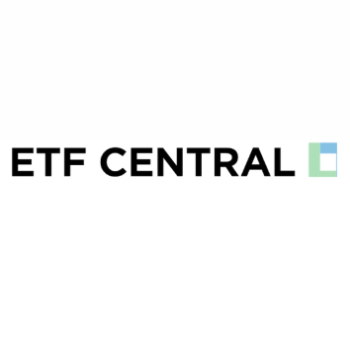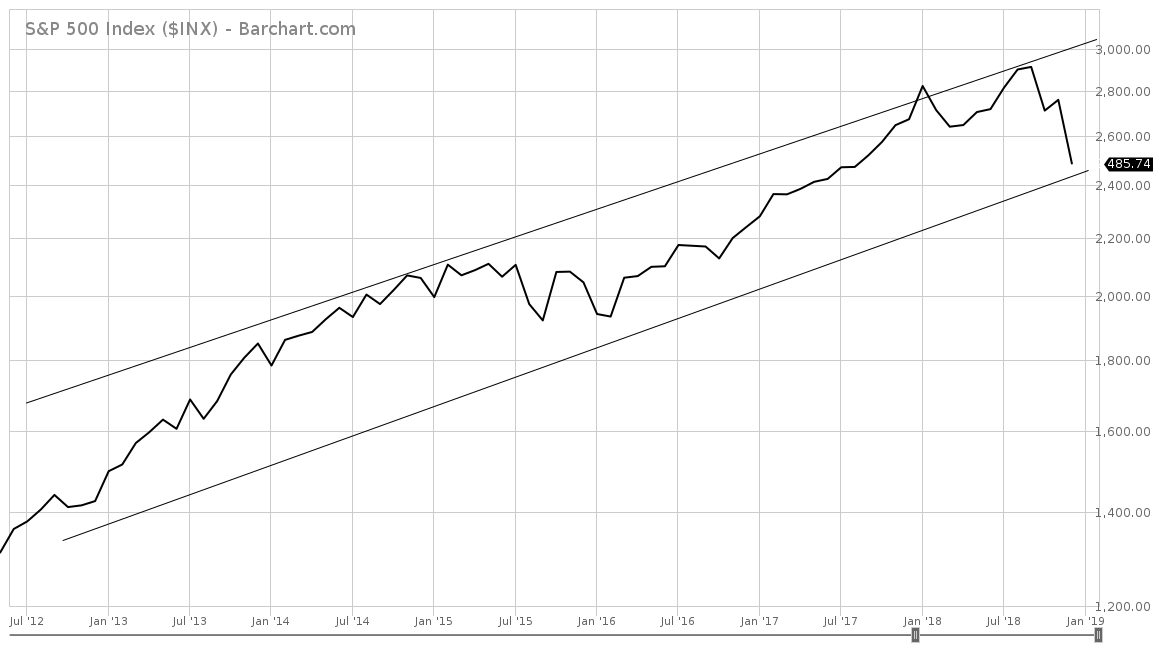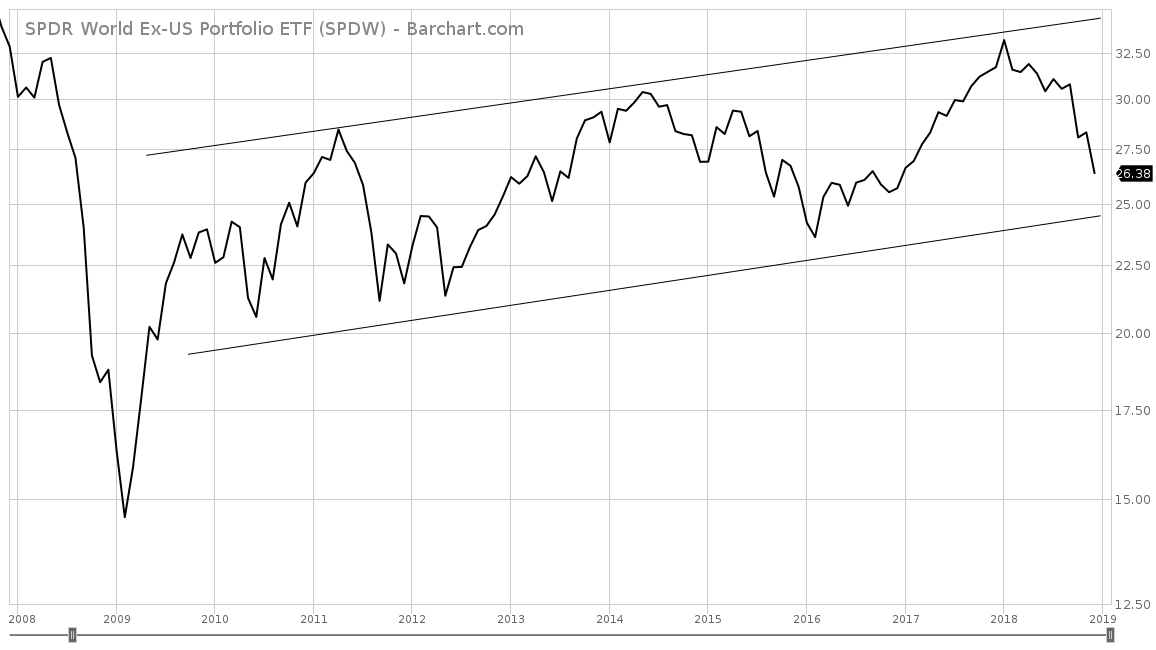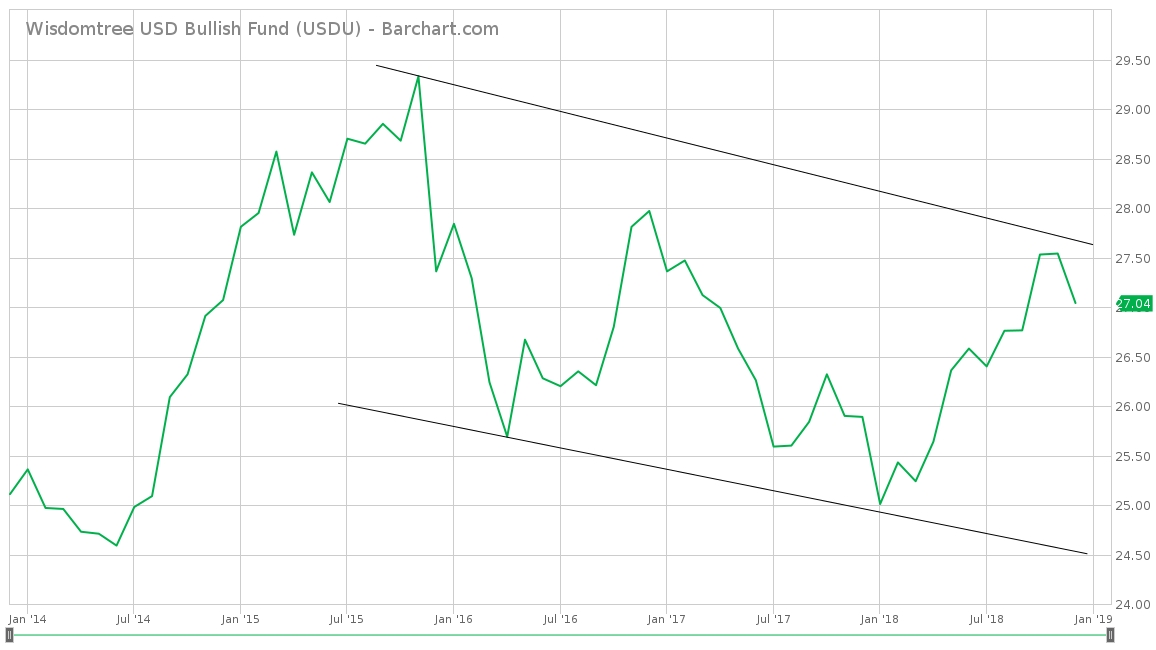
- All Instrument Types
- Indices
- Equities
- ETFs
- Funds
- Commodities
- Currencies
- Crypto
- Bonds
- Certificates
Please try another search

Which stocks will surge next?
Important Stock Market Bottom Underway

Some Revealing Charts
It occurred to me on a walk last night that drawing the weekly trend lines on charts and then switching the charts to monthly with the weekly trend lines remaining is a way to determine when the long-term trend may be at a key inflection point. Here is what this looks like for the S&P 500 Index:
logarithmic scale; chart courtesy of barchart.com
You can see here that the monthly price is still within the weekly bull channel that goes back to October 2012. In other words, the long-term bullish trend is still intact.
It is worth noting that following this method—raising cash when the monthly price nears the top of the weekly channel and deploying cash when the monthly price nears the bottom of the weekly channel—would have helped you reduce exposure right before the last 2 stock market peaks in January 2018 and July 2018.
Here is the same type of chart for the State Street SPDR Portfolio Developed World Ex-US ETF (SPDR S&P World ex US (NYSE:SPDW):
logarithmic scale; chart courtesy of barchart.com
This relationship is even more pronounced for this large capitalization, developed country stocks listed outside the United States.
Another factor at play here is the U.S. dollar. The SPDW turned higher in January 2016, right as the dollar started falling, and has been plummeting in 2018 as the dollar has been climbing.
In the context of decent global economic growth, these 2 charts tell me that (1) stocks are getting ready to put in a bottom and (2) non-US developed market stocks could outperform the S&P 500 in 2019 if I am correct that the U.S. dollar is peaking and getting ready to roll over.
Regarding the U.S. dollar rolling over, consider the following monthly price chart of the WisdomTree Bloomberg US Dollar Bullish Fund ETF (NYSE:USDU) annotated with the weekly price trend line channels:
logarithmic scale; chart courtesy of barchart.com
USDU keeps putting in lower highs and lower lows on the monthly price chart.
Important Buying Opportunity
I expect that stocks have just or will soon (within a few weeks) put in what may prove to be the last great buying opportunity in the current bull market. I would not be surprised to see a shocking, sudden, sharp rise in developed stock markets in the very near future. The U.S. stock market's powerful ~5% rebound on December 26th was a signal that there are a large number of buyers around that lower weekly trend line.
Investors should have their shopping list ready.
Related Articles

Despite its venerable age, the Dow Jones Industrial Average (DJIA) remains a cornerstone of financial market benchmarks, frequently cited alongside the S&P 500 and Nasdaq-100...

As for the economy, the federal government (the Bureau of Economic Analysis) released its third estimate of real gross domestic product (GDP) growth recently at 3.4% (annual rate)...

by Jack FischerDuring LSEG Lipper’s fund-flows week that ended March 27, 2024, investors were overall net redeemers of fund assets (including both conventional funds and...
Are you sure you want to block %USER_NAME%?
By doing so, you and %USER_NAME% will not be able to see any of each other's Investing.com's posts.
%USER_NAME% was successfully added to your Block List
Since you’ve just unblocked this person, you must wait 48 hours before renewing the block.
I feel that this comment is:
Thank You!
Your report has been sent to our moderators for review








Add a Comment
We encourage you to use comments to engage with other users, share your perspective and ask questions of authors and each other. However, in order to maintain the high level of discourse we’ve all come to value and expect, please keep the following criteria in mind:
Enrich the conversation, don’t trash it.
Stay focused and on track. Only post material that’s relevant to the topic being discussed.
Be respectful. Even negative opinions can be framed positively and diplomatically. Avoid profanity, slander or personal attacks directed at an author or another user. Racism, sexism and other forms of discrimination will not be tolerated.
Perpetrators of spam or abuse will be deleted from the site and prohibited from future registration at Investing.com’s discretion.